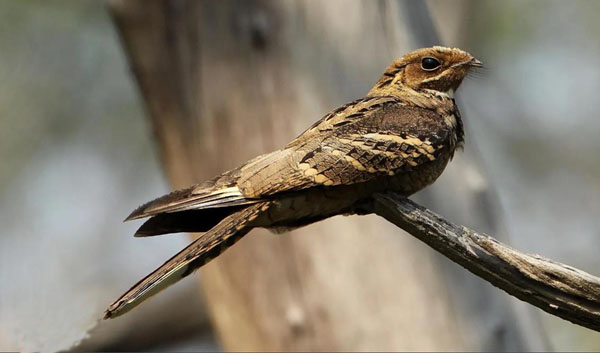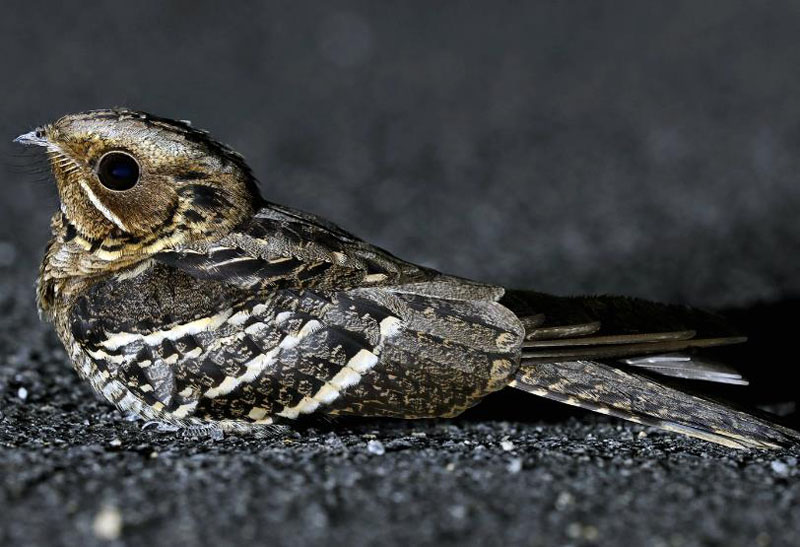Caprimulgus macrurus
IUCN
LCBasic Information
Scientific classification
- name:Caprimulgus macrurus
- Scientific Name:Sticking bark, mosquito-bird,Caprimulgus macrurus,Large-tailed Nightjar
- Outline:Climbing birds
- Family:nighthawks hawks
Vital signs
- length:28-30cm
- Weight:55-90g
- lifetime:8years
Feature
The beak is surrounded by a circle of bristle-like feathers, like a brush.
Distribution and Habitat
In China, it breeds in the tropical lowlands of southern and southeastern Yunnan and Hainan Island. Abroad, it is distributed in the Indian subcontinent, Southeast Asia, the Philippines, Indonesia, New Guinea and Australia.
The long-tailed nightjar inhabits deciduous forests, evergreen broad-leaved forests, farmlands, fallow land, parks, country gardens, plantations and degraded natural forests. It also lives in subalpine or mountain moist tropical and subtropical forests, arid tropical shrub forests, temperate scrublands, tropical and subtropical mangroves, savannas, wetlands and temperate forests. The vertical habitat is 0-2700 meters above sea level.
Appearance
A slightly larger brownish nighthawk, with a gray-brown body covered with moth spots, and a large color patch on the back of the head. The male has obvious white spots in the middle of the outer primary flight feathers and the outer tail feathers; the female is similar to the male, but the white spots are leathery yellow. The iris is brown, the beak is gray-brown, and the feet are dark brown.
Details
The long-tailed nighthawk lives in evergreen broad-leaved forests, shrubs, scrub belts, mangroves, savannas and wetlands. During the day, it often crouches in dense forests or grasslands, and is sometimes seen standing on rocks by the roadside. Because of its small claws, it often moves by jumping on the ground. At dawn and dusk, the long-tailed nighthawk will call for about half an hour on the perch or in flight, and the call is similar to a continuous "tok, tok, tok, tok". When perching on a tree, its body is often parallel to the tree trunk, crouching on the tree trunk. Because its body color is very similar to the color of the tree trunk, it is generally not easy to be found.

Long-tailed nighthawks are active and hunt mostly at dusk, early morning, and at night. Prey include nocturnal insects such as moths, crickets, mosquitoes, termites, beetles and other coleoptera insects, wasps and other small animals. When hunting, long-tailed nighthawks will wait motionlessly, then quietly and swiftly swoop down to catch their prey, and then take a short rest.
This species is very agile and often flies very close to the ground and drifts left and right during hunting. The Long-tailed Nightjar has a special joint on its mandible that allows it to lower its beak even lower during hunting, making it act like a wide shovel for insects. The beak is also surrounded by a circle of bristle-like feathers that act like a brush to move insects into its mouth, preventing them from touching the bird's eyes and reminding the bird to close its beak.

The breeding season for the Long-tailed Nightjar is from March to June each year. During courtship, the two birds approach each other, making low croaking sounds, while the male displays a white crescent pattern on his swollen throat. The male bird does not build a nest. Instead, the female bird will find a shallow depression on the ground as a nest and lay eggs. The eggs are pink, creamy yellow or dark orange-red with light reddish-brown spots. The chicks will have full feathers about 3 weeks after hatching and will be able to fly.








